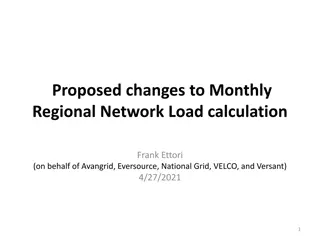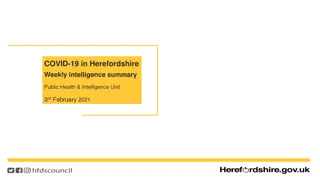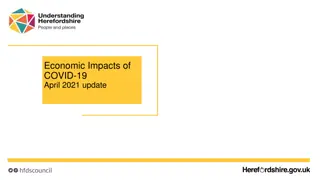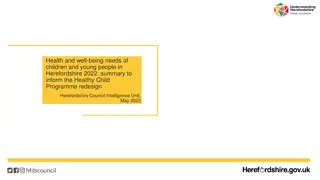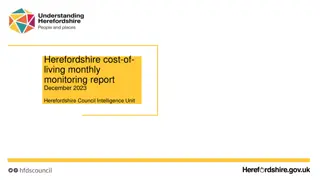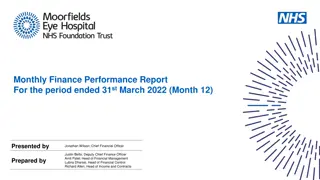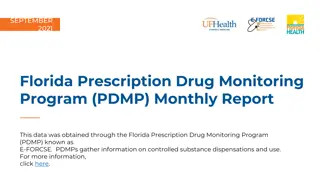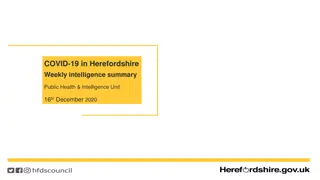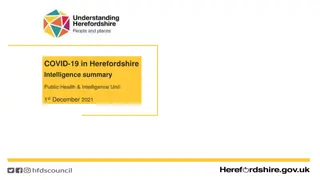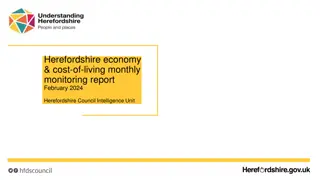Herefordshire Cost of Living Monthly Monitoring Report November 2023 Update
In November 2023, Herefordshire's Cost of Living Monthly Monitoring Report showed a decrease in the rate of inflation, with the Consumer Prices Index (CPI) rising by 4.6% over the past 12 months. While inflation slowed, cost of living pressures persist. The number of people claiming Universal Credit is rising, surpassing pandemic levels, while out-of-work-related benefits claims remain high. Job postings increased significantly compared to last year. The report also details key inflation data and highlights the importance of the CPI and CPIH measures. For further details or assistance, contact Herefordshire Council.
Uploaded on Oct 02, 2024 | 1 Views
Download Presentation

Please find below an Image/Link to download the presentation.
The content on the website is provided AS IS for your information and personal use only. It may not be sold, licensed, or shared on other websites without obtaining consent from the author.If you encounter any issues during the download, it is possible that the publisher has removed the file from their server.
You are allowed to download the files provided on this website for personal or commercial use, subject to the condition that they are used lawfully. All files are the property of their respective owners.
The content on the website is provided AS IS for your information and personal use only. It may not be sold, licensed, or shared on other websites without obtaining consent from the author.
E N D
Presentation Transcript
Herefordshire cost-of- living monthly monitoring report November 2023 Herefordshire Council Intelligence Unit
About the monthly monitoring report The monthly monitoring report is a supplementary report to the quarterly Cost-of-Living Bulletin and provides the latest data from the limited number of datasets that are updated on a monthly basis. If you need help to understand this document, or would like it in another format or language, please contact us on 01432 261944 or e-mail researchteam@herefordshire.gov.uk
Key points (sections 1 & 2) The rate of Inflation fell markedly in October - the Consumer Prices Index (CPI) rose by 4.6% in the 12 months to October 2023; down from 6.7% in September. Whilst this is welcome news, it means that the rate at which cost of living pressures are worsening has slowed not that things are getting better. The number of people claiming Universal Credit is gradually increasing and is significantly higher than the pandemic peak. The number of people claiming out-of-work related benefits fell slightly again in October but numbers remain significantly higher now than pre-pandemic. The number of unique job postings rose significantly in October 2023 and was higher than in the same month last year and immediately prior to the pandemic.
Inflation Key points ONS reports that the Consumer Prices Index including owner occupiers' housing costs (CPIH) rose by 4.7% in the 12 months to October 2023, down from 6.3% in September. On a monthly basis, CPIH rose by 0.1% in October 2023, compared with a rise of 1.6% in October 2022. The Consumer Prices Index (CPI) rose by 4.6% in the 12 months to October 2023, down from 6.7% in September. On a monthly basis, CPI did not change in October 2023, compared with a rise of 2.0% in October 2022. The largest downward contribution to the monthly change in both CPIH and CPI annual rates came from housing and household services, where the annual rate for CPI was the lowest since records began in January 1950. The second-largest downward contribution to the monthly change in both CPIH and CPI annual rates came from food and non-alcoholic beverages where the annual rate was the lowest since June 2022. Core CPIH (excluding energy, food, alcohol and tobacco) rose by 5.6% in the 12 months to October 2023, down from 5.9% in September; the CPIH goods annual rate fell from 6.2% to 2.9%, while the CPIH services annual rate fell from 6.3% to 6.2%. Core CPI (excluding energy, food, alcohol and tobacco) rose by 5.7% in the 12 months to October 2023, down from 6.1% in September; the CPI goods annual rate fell from 6.2% to 2.9%, while the CPI services annual rate fell from 6.9% to 6.6%. Need to know: The Consumer Prices Index including owner occupiers' housing costs (CPIH) is the lead and most comprehensive measure of consumer price inflation CPIH includes a measure of the costs associated with owning, maintaining and living in one's own home, known as owner occupiers' housing costs (OOH), along with Council Tax. Both are significant expenses for many households and are not included in the CPI. However, the Consumer Prices Index (CPI) is based on a harmonised methodology developed by Eurostat and allows for international comparisons to be drawn. Source: ONS Last updated: 15 November 2023 Frequency of update: Monthly Next update: 20 December 2023
People claiming Universal Credit (UC) Key points The number of people claiming the Universal Credit (UC) doubled between March 2020 and May 2020. Since then claimant numbers have remained at a high level and are currently on a gradual upward trend. Provisional data suggest there were 12,945 Universal Credit in claimants in Herefordshire in October 2023: an increase of 184 from August and more than the pandemic peak of 12,382 in April 2021. In Herefordshire, UC claimants currently comprise 12% of the working age population; lower than the West Midlands Region (17%) and England (15%) but still more than double the 5% seen in March 2020. The wards with the highest number of UC claimants were Hinton & Hunderton (759) and Newton Farm (669) followed by Leominster East (507), and Widemarsh (492). In August 2023, there were 9,534 households in Herefordshire claiming Universal Credit, down slightly from 9,545 in July 2023 (both provisional) . Of these households over a half (5,143) contained at least one child. Data source: Department for Work & Pensions (Stat-Xplore) Last updated: 28 November 2023 Frequency of update: Monthly Next update: 12 December 2023 Need to know: The monthly number of people on Universal Credit includes all individuals who have an open claim on the count date for the month. Some people will have their claim terminated either at the request of the individual or if their entitlement to Universal Credit ends. If a termination is recorded, but the person is still receiving a payment, then the claim will still be classed as live at the end of each reporting month. The latest month's figures are provisional and are subject to change in the next publication where they will be revised and finalised. Monthly figures are currently not subject to retrospection beyond the first revision.
Out-of-work related claimant count: all ages Key points 2,440 people aged 16+ in Herefordshire were claiming unemployment related benefits* in October 2023: down from the previous month by 25 claimants. Numbers remain significantly higher than pre-pandemic levels, being 16% higher than in March 2020; a smaller increase than in England as a whole (26%). There are currently around 685 fewer claimants than the peak in the aftermath of the Great Recession (February 2012). The claimant count rate a proportion of residents aged 16-64 was 2.2% in October 2023 compared to 3.8% for England and 4.8% for the West Midlands region. What this doesn t tell us: Claimant count is NOT a full measure of unemployment, but it is the most timely indicator. From these data, we do not know which industry sector(s) any increases or decreases are being driven by. Data source: ONS - NOMIS Date last updated: 14 November 2023 Frequency of update: Monthly Next update: 12 December 2023 Need to know *Includes people claiming Jobseeker's Allowance plus those claiming Universal Credit who are required to seek and be available for work. Month-by-month comparisons are difficult as previous data is often revised
Out-of-work claimant count by ward Key points Generally, those wards with the highest numbers of claimants before the pandemic still have the highest numbers now. In October 2023, the wards with the highest numbers of claimants were Hinton & Hunderton (150), Widemarsh (125), Newton Farm (110) and Leominster East (100). The largest proportional increases in the claimant count since March 2020 have occurred in Kerne Bridge (150%), Ledbury South (100%) and Bircher (75%). In terms of numerical increases, the largest have been by 45 claimants, Ledbury South (30 claimants) and Hinton & Hunderton (20 claimants). Data source: ONS - NOMIS Date last updated: 14 November 2023 Frequency of update: Monthly Next update: 12 December 2023
Age distribution of out-of-work claimants Key points Since before the start of the Financial Crisis in January 2008, the age distribution of claimants has changed significantly. Before the Financial Crisis (January 2008), 18 to 24 year olds accounted for 27% of claimants and over 50s accounted for 19% of claimants. By October 2023 (the latest data available), 18 to 24 year-olds accounted for 18% of claimants and over 50s 26% of claimants reversing the distribution at the start of the period. This trend is partly a reflection of our ageing workforce but may also be an indicator of discrimination in the labour market whereby older workers who want to work find it harder to find another job than they did in the past. Recent IFS research suggests that nationally many older workers were forced out of employment (through the jobs they were in not being compatible with home working and/or health fears) during the COVID-19 pandemic and that people who become inactive at older ages often never re-enter the workforce. Recent IFS research NOMIS Data source: ONS - NOMIS Date last updated: 14 November 2023 Frequency of update: Monthly Next update: 12 December 2023
Job postings Key points In Herefordshire, during the period November 2022 to October 2023 there were 59.532 job postings, of which 22,527 were unique. The number of unique posting rose in October 2023 to 5,334: up from 3,789 in September (+41%). Looking at the past 5 years of data, posting levels remain at a relatively high level and in October 2023 were higher than a year ago (3,374 in October 2022) and immediately before the first pandemic lockdown (3,354 in February 2020). The top ten posted occupations (SOC 3 level) in the period November 2022 to October 2023 were caring personal services (1,777 unique postings), nursing professionals (1,037), sales related occupations (961) and other elemental service occupations (865). Top posted job titles in this period were support workers (733 unique postings), healthcare assistants (293), cleaners (246) and care assistants (215). The most in-demand specialized skills in this period (by frequency in job postings) were auditing, finance and nursing. Need to know: A unique job posting is one that has been de-duplicated as postings can appear on multiple websites, multiple times. Data include voluntary, internships, side jobs and freelance. The Standard Occupational Classification (SOC) is a common classification of occupational information for the UK and comprises 4 tiers with 4 being the most detailed. Source: Lightcast (EMSI): economicmodelling.co.uk Date last updated: 6 November 2023 Frequency of update: Monthly Next update: December 2023
In-demand skills Top hard skills (October 2021 October 2023) Top 10 hard skills by quarter Need to know: Hard skills are abilities that have been taught to or learnt by a person. Source: Lightcast (EMSI): economicmodelling.co.uk Date last updated: 6 November 2023 Frequency of update: Monthly Next update: December 2023
Hard to fill vacancies Key points Median Posting Duration from Nov 2022 - Oct 2023 There is no standard definition of a hard- to-fill vacancy but the table below shows those occupations (SOC 3 level) for the period November 2022 to October 2023 with a higher than average posting intensity. Those which also have a higher than average median posting duration (highlighted in red) are likely to be those most difficult to fill (table is in ascending order of difficulty).. Avg. Posting Intensity (Nov 2022 - Oct 2023) Unique Postings from Nov 2022 - Oct 2023 SOC 924 222 246 821 115 212 216 225 221 525 322 613 117 223 116 Occupation Elementary Sales Occupations Therapy Professionals Welfare Professionals Road Transport Drivers Managers and Directors in Retail and Wholesale Engineering Professionals Research and Development (R&D) and Other Research Professionals Other Health Professionals Medical Practitioners Skilled Metal, Electrical and Electronic Trades Supervisors Welfare and Housing Associate Professionals Caring Personal Services Health and Social Services Managers and Directors Nursing Professionals Senior Officers in Protective Services 4 : 1 4 : 1 4 : 1 4 : 1 4 : 1 4 : 1 4 : 1 4 : 1 4 : 1 4 : 1 5 : 1 5 : 1 6 : 1 7 : 1 7 : 1 31 32 33 33 34 34 34 36 38 39 30 32 33 32 35 53 276 698 592 347 620 51 237 236 89 314 This is the most timely proxy for hard-to- fill vacancies and although there are some issues associated with this methodology, it has been shown to be a robust approximation. 1,777 281 1,037 16 Source: Lightcast (EMSI): economicmodelling.co.uk Date last updated: 6 November 2023 Frequency of update: Monthly Next update: December 2023 Need to know: Posting Intensity is a ratio of total job postings to unique, or de-duplicated, job postings. A higher than average posting intensity can mean that employers are putting more effort than normal into hiring that position. Posting intensity is available by occupation, by job title, by company, and by region. The median posting duration (how long a posting was live before it was taken down) can be compared to the regional average for all postings in the region, giving an indication of whether these positions are harder or easier to fill than the typical job posting.







